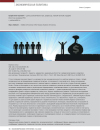Poverty, Inequality, National Wealth: Empirical Analysis and Policy Implications
DOI: https://doi.org/10.33917/es-4.184.2022.70-81
The article is devoted to the study of poverty and inequality in the economic growth of the most developed countries, with a general focus on the formation of social policy consistent with the growth policy. The purpose of the study is to conduct a macroeconomic analysis of poverty, inequality and wealth in the G7 countries, China and Russia, with the ensuing substantiation of a social development strategy for the Russian economy. The methodology is made up of empirical analysis, as well as regression modeling, which make it possible to identify in a comparative way the connectivity of the dynamics of relevant indicators of social development — the level of national poverty and wealth, the Gini coefficient and general inequality, growth rate, human development index. The result of the study is a precisely confirmed empirical relationship between the level of poverty and inequality for the countries considered, that is, a high value of one parameter corresponds to a high value of another. Consequently, poverty reduction may imply a reduction in inequality, and not only relative, but also absolute. In addition, it was found that for developed countries, high levels of poverty and inequality mean low values of the human development index. Social policy aimed at human development requires that its instruments be harmonized, including the necessary alignment with the current macroeconomic policies to stimulate growth. The magnitude of national wealth does not guarantee high growth rates, as well as low levels of inequality and poverty. A high level of inequality can accompany economic growth, having a positive effect on the growth rate, as for the Russian economy. In this regard, the current policy needs a reasonable selection of measures to stimulate growth and, at the same time, measures to reduce inequality, which can and should not be limited only to tax changes that require special confirmation of influence, but to institutional changes that regulate the creation and appropriation of income.
Источники:
1. Aganbegyan A.G. Kak preodolet’ stagnatsiyu i novyi krizis, obespechiv sotsial’no-ekonomicheskii rost [How to Overcome Stagnation and New Crisis, Providing Socio-Economic Growth]. Ekonomicheskie strategii, 2020, vol. 22, no 5, pp. 34–45, DOI: 10.33917/es-5.171.2020.34-45; no 6, pp. 6–19, DOI: 10.33917/es-6.172.2020.6-19.
2. Adzhimoglu D., Robinson Dzh.A. Pochemu odni strany bogatye, a drugie bednye. Proiskhozhdenie vlasti, protsvetaniya i nishchety [Why Some Countries are Rich and Others are Poor. The Origin of Power, Prosperity and Poverty]. Moscow, AST, 2016, 693 p.
3. Livshits V.N. Bednost’ i neravenstvo dokhodov naseleniya v Rossii i za rubezhom [Poverty and Inequality of the Population Incomes in Russia and Abroad]. Moscow, IE RAN, 2017, 52 p.
4. Stiglits Dzh. Tsena neravenstva. Chem rassloenie obshchestva grozit nashemu budushchemu? [The Cost of Inequality. How does Social Stratification Threaten Our Future?]. Moscow, Eksmo, 2015, 512 p.
5. Sukharev O.S. Sotsial’naya politika v reshenii problemy neravenstva i bednosti [Social Policy in Addressing the Problem of Inequality and Poverty]. Ekonomika. Nalogi. Pravo, 2021, vol. 14, no 2, pp. 16–31.
6. Sukharev O.S. Ekonomicheskii rost i neravenstvo: peresmotr ekonomicheskoi politiki [Economic Growth and Inequality: Revision of the Economic Policy]. Ekonomicheskie strategii, 2021, vol. 23, no 2, pp. 76–87, DOI: https://doi.org/10.33917/es-2.176.2021.76-87.
7. Kuznets S. Modern Economic Growth: Findings and Reflections. The American Economic Review, 1973, vol. 63, no 3, pp. 247–258.
8. Ridzuan S. Inequality and the environmental Kuznets curve. Journal of Cleaner, 2019, vol. 228, pp. 1472–1481.
9. Shevyakov A.Yu. Mify i realii sotsial’noi politiki [Myths and Realities of Social Policy]. Moscow, ISEPN RAN, 2011, 76 p.
10. Wan G., Hu X., Liu W. China’s poverty reduction miracle and relative poverty: Focusing on the roles of growth and inequality. China Economic Review, 2021, August , vol. 68, 101643.
11. Breunig R., Majeed O. Inequality, poverty and economic growth. International Economics, 2020, May, vol. 161, pp. 83–99.
12. Adeley B.N., Gershon O., Ogundipe A., Owolabi O., Ogunrinola I., Adediran O. Comparative investigation of the growth-poverty-inequality trilemma in Sub-Saharan Africa and Latin. Heliyon, 2020, December, vol. 6, iss. 12, e05631.
13. Fosu A.K. Growth, inequality, and poverty reduction in developing countries: Recent global evidence. Research in Economics, 2017, June, vol. 71, iss. 2, pp. 306–336.
14. Deutsch J., Silbera J., Wan G., Zhao M. Asset indexes and the measurement of poverty, inequality and welfare in Southeast Asia. Journal of Asian Economics, 2020, October, vol. 70, 101220.
15. Zhang R., Naceur S.B. Financial development, inequality, and poverty: Some international evidence. International Review of Economics & Finance, 2019, May, vol. 61, pp. 1–16.
16. Freeman S. MD The Current Global Reality: Poverty and Income Inequality. Seminars in Pediatric Neurology, 2018, October, vol. 27, pp. 1–9.
17. Wiwad D., Mercier B., Piff P.K., Shariff A., Aknin L. B. Recognizing the Impact of COVID-19 on the Poor Alters Attitudes Towards Poverty and Inequality. Journal of Experimental Social Psychology, 2021, March, vol. 93, 104083.
18. Palomino J.C., Rodríguez J.G., Sebastian R. Wage inequality and poverty effects of lockdown and social distancing in Europe. European Economic Review, 2020, vol. 129, 103564.
19. Wray R. Part C — Tackling poverty and inequality. The road to full employment and price stability. A Great Leap Forward Heterodox Economic Policy for the 21st Century, 2020, pp. 85–135.
20. Seven U., Coskun Y. Does financial development reduce income inequality and poverty? Evidence from emerging countries. Emerging Markets Review, 2016, March, vol. 26, pp. 34–63.
21. Sotomayor O.J. Can the minimum wage reduce poverty and inequality in the developing world? Evidence from Brazil. World Development, 2021, February, vol. 138, 105182.
22. Global wealth data book, available at: https://www.credit-suisse.com/media/assets/corporate/docs/about-us/research/publications/global-wealthdatabook-2019.pdf.
23. Koeffitsient bednosti po natsional’noi cherte bednosti (% naseleniya) [Poverty Ratio According to National Poverty Line (% of Population)]. Vsemirnyi bank, available at: https://data.worldbank.org/indicator/SI.POV.NAHC?view=chart
24. Indeks Dzhini [Gini Index]. Vsemirnyi bank, available at: https://data.worldbank.org/indicator/SI.POV.GINI?view=chart.
25. Analiz situatsii v oblasti chelovecheskogo razvitiya [Analyzing Situation in the Human Development Field]. OON. Human Development Report, available at: http://hdr.undp.org/en/indicators/137506#
26. Human Development Report, available at: https://hdr.undp.org.



